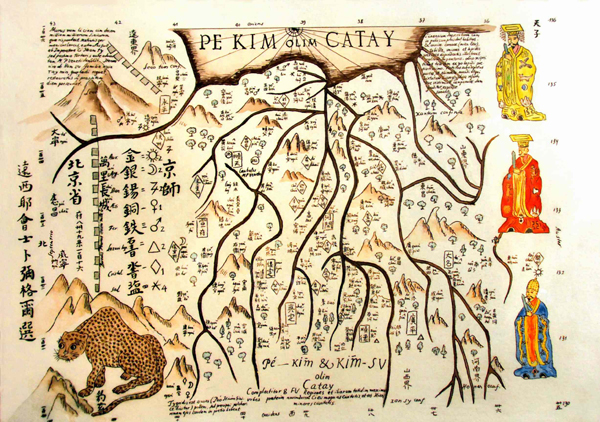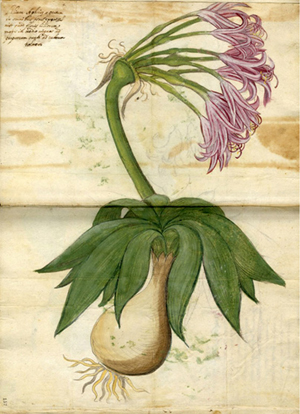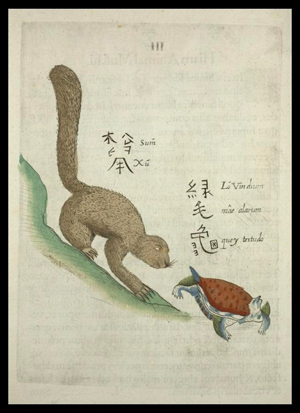|
||||||||||
|
NEW SCHOLARSHIPVenturing into Magnum CathaySeventeenth-century Polish Jesuits in China: Michał Boym S.J. (1612–1659), Jan Mikołaj Smogulecki S.J. (1610–1656) and Andrzej Rudomina S.J. (1596–1633)A report by Barbara Hoster and Dirk Kuhlmann on a conference held in Kraków, Poland, 26-30 September 2009 Fig. 1 An illustration of Peking and surrounds, by Michał Boym This international workshop held in commemoration of three Polish China missionaries was co-organized by the Monumenta Serica Institute, Sankt Augustin (Germany) and the Confucius Institute Kraków, in cooperation with the Monumenta Serica Sinological Research Center, Taipei. Twenty-seven scholars from Europe, the United States, the People's Republic of China, Taiwan and Australia were invited to deliver their papers at the Jesuit University of Philosophy and Education 'Ignatianum' in Kraków. The activities of Polish Jesuits in seventeenth-century China still constitute something of a terra incognita in Sinological research. In particular, sources from Polish archives and libraries have been largely neglected. By choosing Kraków, the city that nurtured the three missionaries in question, as the venue for this workshop, special emphasis was laid on introducing the socio-cultural background of seventeenth-century Poland into academic discourse and promoting scholarly exchange between Polish historians of Jesuit history and international Sinologists. A visit to the Jagiellonian Library in Kraków during the workshop suggested a more systematic exploration of important Polish collections on the China mission and Sino-European (and by extension 'Western') relations. The workshop programme also included a visit to the Botanical Garden of the Jagiellonian University which coincided with the opening of an exhibition of hand-coloured drawings by Edward Kajdański inspired by illustrations of Michał Boym's botanical work Flora Sinensis (Chinese Flora).  Fig. 2 Illustration from Michał Boym's Flora Sinensis The 350th anniversary of the death of Michał Boym, known in Chinese as 卜彌格爾, in 2009 seemed an apt opportunity to recall the outstanding contributions of this Jesuit in introducing things Chinese to the Europeans, namely through his studies in botany, medical science, geography, cartography and historiography. Another aim of the workshop was to probe deeper into Boym's unique role as an 'imperial' legate of the Southern Ming court to Pope Innocent X. His fellow missionaries Jan M. Smogulecki and Andrzej Rudomina are to be remembered for their roles in transmitting mathematical and astronomical knowledge to the Chinese and for mission work in Fujian, respectively. In his opening lecture on the Jesuit China mission in general Nicolas Standaert S.J. (KU Leuven) stressed the fact that the Jesuits were also shaped by the Chinese, due to what the late Sinologist Erik Zürcher once termed the Chinese 'cultural imperative'. The first session of the workshop was devoted to the cultural-historical background of seventeenth-century Poland. Jan Konoir S.J. (Ignatianum, Kraków) emphasized the enormous influence of the Jesuit educational system on Polish culture and also on the culture of entire Middle Eastern Europe. Justyna Łukaszewska-Haberkowa (Ignatianum, Kraków) presented the results of her research on the records of exams (examina novitiorum) and autobiographical sources of Jesuit probationers in Braniewo from the late-sixteenth century, exploring the question why only a small percentage of Polish Jesuits was permitted to take part in the overseas missions of the Society. Monika Miazek-Męcyńska (Collegium Europaeum Gnesnense, Gniezno) analysed contents and style of Michał Boym's Indipetae, that is, his ten letters to the Jesuit General containing his application for the Far East mission. Claudia von Collani (Würzburg) explored Boym's attitudes towards the adherents of different religions he encountered on his journey to China. The second session, on Boym in the seventeenth-century China mission, was opened by Paul Rule (La Trobe University, Melbourne) with a lecture on the role of the Jesuits in the Ming-Qing transition, especially on Boym's mission to Europe in the name of the Ming contender Yongli 明永曆, as compared to the concurrent mission of his fellow Jesuit and opponent Martino Martini (1614–1661). Ren Dayuan 任大援 (Graduate School of the China Art Academy, Beijing) presented, in absentia of his collaborator Zhang Xiping 張西平 (ibid.) some documents from the Archivum Romanum Societatis Iesu (ARSI) in Rome concerning the Yongli emperor, his mother and the Christian eunuch Achilles Pang (Pang Tianshou) that shed new light on the role of the Jesuit missionaries at the Southern Ming court. Tereza Sena's (Lisbon/Macau) paper focussed on Boym's legation to Europe from the perspective of the city of Macau, making use of non-ecclesiastical sources and local historiography. John W. Witek S.J. (Georgetown University) presented Boym as the first translator of the so-called 'Nestorian Monument' into Latin. Athanasius Kircher included Boym's translation in his famous work China…illustrata (1667), which decisively shaped early western images of China. Witek also compared Boym's translation to a later, richly annotated work by the French Jesuit Claude Visdelou (1656–1737).  Fig. 3 Participants in the conference Eugenio Menegon (Boston University) showed how Andrzej Rudomina introduced European religious images to Chinese literati. Rudomina used allegorical and emblematic pictures in his catechetical conversations in Fujian, which are recorded in the Kouduo richao 口鐸日抄 (an annotated English translation of this work by Erik Zürcher has been published in the Monumenta Serica Monograph Series: Kouduo richao. Li Jiubiao's Diary of Oral Admonitions. A Late Ming Christian Journal, 2 vols., Sankt Augustin-Nettetal 2007. See http://www.steyler-missionare.de/svd/dcms/sites/monumenta_serica/monumenta_english/publications/ms_monographs/msms_56.1-2_zuercher). Boym's achievements in making Chinese botanical and medicinal knowledge accessible to the European academia were highlighted in the third session. Stanislaw Cieslak S.J. (Ignatianum, Kraków) emphasized the importance of Boym's family background in this context: Like his father, who was the personal physician to Sigismund III Vasa, King of Poland, Michał Boym had studied medicine in Padua, a fact that proved to be a new biographical information for the participants. Starting with the field of botany, the lecture of Hartmut Walravens (Berlin) concentrated on the value of Boym's Flora Sinensis as a scientific source material and the history of its reception, for example, in the works of Athanasius Kircher and Olfert Dapper. Chang Sheng-ching 張省卿 (Fu Jen University, Taipei) compared the illustrations in the Flora made by Michał Boym to those used by his contemporaries Kircher and Johann Nieuhof. Boym's main technique of representing plants included drawings of a full-grown specimen, a fruit (whole and cross-sectional view) and seeds on a blank background. According to Chang, this should be considered a proto-scientific approach, esp. in contrast to Kircher and Nieuhof each of whom had chosen an artistic mode of presentation, showing the plant embedded within a highly imaginary Chinese landscape. This statement sparked a lively discussion, in which it was stressed that while Boym's Flora was predominately based on first-hand experience employing an empirical approach, it also was firmly rooted in a traditional Christian worldview. Boym's research on Chinese medicine was led by a universal concept of science, as Erhard Rosner (Göttingen) pointed out in his lecture on the Clavis medica: Boym went beyond introducing Chinese medicinal theories and methods as a mere curio to the West, engaging with the various merits and flaws of Chinese as well as Western Renaissance approaches with the aim of improving medical science as a whole. Edward Kaydanski (Gdansk) traced the reception and appropriation of aspects of Chinese medicine and pharmacy by Boym in his works Clavis medica, Specimen Medicinae Sinicae and the Medicamenta Simplicia. In addition, Kaydanski offered an overview on his pioneering studies on Boym, which he began thirty years ago. The fourth session, which was held in the Jagiellonian Library, was dedicated to various other relevant historical sources. Robert Danieluk S.J. (ARSI, Rome) provided an introduction to the sources and catalogues of the ARSI as well as to the research tools available to scholars there. Adrian Dudink's (KU Leuven) lecture tentatively reconstructed the number and titles of the books Rudomina had sent to the Jesuit Superior of the Lithuanian province from Hangzhou in July 1627. In this, Dudink made an argument for re-evaluating the provenience of the copy of Matteo Ricci's Tianzhu shiyi 天主實義 (True meaning of the Lord-on-High) held in the ARSI: while this work is commonly regarded as having been annotated by Ricci himself, according to Dudink, the handwritten commentaries are rather more congruent with the style of Rudomina. The intriguing publication history of the Flora Sinensis was revealed by Noël Golvers (KU Leuven). Golvers considers the work to have originally been conceived as source material to be inserted as illustrations into an atlas of China, but in the end Boym did not receive an imprimatur for this project from the Jesuit General. Instead, his rival Martino Martini S.J. successfully published his Novus Atlas Sinensis.  Fig. 4 Illustration from Michał Boym's Flora Sinensis In a public lecture Ludwig Grzebien S.J. (Ignatianum, Kraków), the doyen of researchers on the history of the Polish Jesuit mission, analysed the perception of 'Asia' in seventeenth-century Poland, a construct intimately related to the Catholic missionary movement. The fifth session of the workshop focussed on Andrzej Rudomina and Jan Mikołaj Smogulecki, with special consideration of the Chinese-Western dialogue on religion and science. Song Gang 宋剛 (University of Hong Kong) emphasized the strategic use of dialogue in the above-mentioned Kouduo richao (Diary of Oral Admonitions), the dialogical form being an important instrument that helped the Jesuit missionaries in their conversations with Chinese literati to create a hybrid Christian-Confucian identity. The contribution by Jiang Ryh-Shin 江日新 (Taipei) and Pan Fengchuan 潘鳳娟 (National Taiwan Normal University, Taipei) also dealt with the Kouduo richao, analysing Rudomina and his confrere Giulio Aleni's (1582–1649) different theological approaches in their discourses with Chinese converts. Lezek Gęsiak S.J. (Ignatianum, Kraków) presented Smogulecki as a pioneer of scientific dialogue, who as a trained mathematician introduced logarithmic calculation, which had been unknown in China so far, to Chinese scholars. Interactions between the three Polish Jesuits and Chinese literati in the field of natural science, primarily astronomy, were analysed in the sixth session. Sylvia Witkowska (Institute of Oriental Studies, Poznań) explored Smogulecki's formative years prior to his journey to China, with an emphasis on his adaptation of the Copernican heliocentric world system, condemned by the Catholic church in the early seventeenth century. The other two contributors demonstrated that the process of scientific exchange was to a great part initiated and shaped by the specific interests of the literati: Shi Yunli's 石雲里 (University of Science and Technology of China, Hefei) case study was based upon the Tianbu zhenyuan 天步真原 (The True Origin of Celestial Movements) of 1653, a translation of Western works on astronomy and astrology compiled by Smogulecki and Xue Fengzuo, which made use of the Copernican system. Han Qi 韓琦 (Institute for the History of Natural Science, Beijing) presented the history of the propagation as well as reception of Western astronomy and astrology in China in the time of Johann Adam Schall von Bell and Smogulecki. Joanna Wasilewska (Asia and Pacific Museum, Warsaw) provided the audience of her public lecture with an identification of possible Chinese sources of inspiration for the illustrations Boym used in his map of China. That such sources existed is highly probable according to Wasileswka, given for example the strong resemblance of the mode of depiction on Boym's map to the 'meticulous brush' or gongbi 工筆 of traditional Chinese painting. As the final discussion confirmed, the workshop succeeded in providing a comprehensive overview on the state-of-the-field concerning Boym, Smogulecki and Rudomina. The international participants appreciated in particular the opportunity to familiarize themselves with research in Poland and to establish contacts with Polish scholars of various disciplines. Thus, the gathering in Kraków opened up new opportunities for further in-depth explorations of this topic. Among other things, there is a tentative suggestion that a conference on Smogulecki be held in 2010, on the occasion of the 400th anniversary of his birth. The contributions to this workshop will be published in the Monumenta Serica Monograph Series. A detailed schedule of the workshop is provided on the Monumenta Serica Institute's web-site (see: http://www.steyler-missionare.de/svd/dcms/sites/monumenta_serica/monumenta_english/institute/activities_of_ims/conf_venturing_into_magnum_cathay.html). |